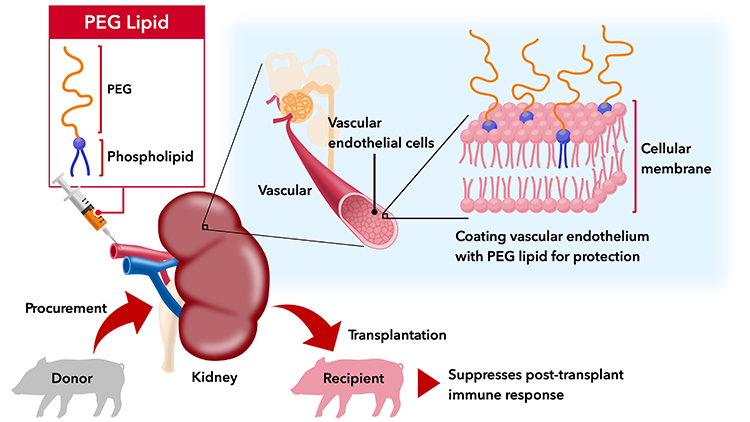Researchers) TERAMURA Yuji, Group Leader, Cellular and Molecular Biotechnology Research Institute
- Vascular endothelial coating technology with PEG-lipid was applied to pig kidneys to suppress immune reactions in pig kidney transplant studies
- Coating conditions suitable for clinical kidney transplantation were optimized
- Clinical trials are underway aiming to improve long-term graft survival rates in human kidney transplantation

Transplantation studies using coating technology with amphiphilic polymer (PEG lipid) for the vascular endothelium in pig kidneys
The number of chronic kidney disease patients in Japan is estimated at 20 million, of whom 350,000 require hemodialysis as of the end of 2022. Dialysis patients must undergo 4-hour hemodialysis sessions three times a week, significantly reducing their quality of life (QOL). Furthermore, patients undergoing hemodialysis are prone to complications, with many dying from heart failure or diabetes. Moreover, the high cost of medical care places a burden on both the patients themselves and the national treasury.
When kidney disease patients cannot halt losing kidney function, they require treatment through dialysis or kidney transplantation. Reports indicate that the 10-year survival rate after treatment initiation is superior for kidney transplantation. A WHO report from October 2020 stated that approximately 95,000 kidney transplants were performed worldwide, with this number increasing annually. Kidney transplantation is becoming established as the most common therapy in transplant medicine. However, if the transplanted kidney fails to engraft and function stably within the patient's body over the long term, re-transplantation becomes necessary within a few years. Currently, the number of donors is insufficient, making re-transplantation difficult. Therefore, there is a demand for drugs and techniques that enable the transplanted kidney to engraft stably within the patient.
Previous research has shown that ischemia-reperfusion injury occurring immediately after kidney transplantation is one key factor lowering graft engraftment rates. Ischemia-reperfusion injury is an immune response occurring shortly after kidney transplantation, involving complex interactions such as activation of innate immunity, activation of blood coagulation reactions, and generation of reactive oxygen species, which cause damages to the cells and tissues of the transplanted kidney. Therefore, controlling ischemia-reperfusion injury with a single drug is difficult, and no drug or technique has been found that can effectively suppress ischemia-reperfusion injury.
Researchers at AIST in collaboration with iCoat Medical AB and Uppsala University in Sweden have developed a technology to suppress ischemia-reperfusion injury occurring after kidney transplantation by coating the kidney vascular endothelium with amphiphilic polymers.
Since kidney transplantation is the only treatment enabling patients with severe kidney disease to avoid dialysis, it is crucial to make long-term engraftment of the transplanted kidney in the patient's body. We require suppressing the immune response that causes organ damage during transplantation. Here we used a coating technology based on PEG lipids—an amphiphilic polymer composed of polyethylene glycol (PEG) and phospholipids. In pig studies, we applied the coating technology to the surface of vascular endothelium within the kidney and demonstrated suppression of ischemia-reperfusion injury, which is one of the immune reactions occurring after kidney transplantation.
Details of these findings will be published in the American Journal of Transplantation on September 24, 2025.
Furthermore, during the course of this technical development, including the pig kidney transplantation experiments, we clarified the optimal coating conditions applicable to clinical kidney transplantation. To date, no drug has been found that can effectively suppress ischemia-reperfusion injury, which significantly reduces the graft engraftment rate in human kidney transplantation. The outcome has largely depended on the experience and technique of the transplant surgeons. The developed coating technology is expected to contribute to improving the graft survival rate of human kidney transplants, and clinical trials utilizing this technology are currently underway.
Journal: American Journal of Transplantation
Title of paper: A new principle to attenuate ischemia-reperfusion injury in kidney transplantation
Authors: Ali-Reza Biglarnia*, Yuji Teramura*, Sana Asif, Claudia Dührkop, Vivek Arnand Manivel, Elin Manell, Patricia Hedenqvist, Anneli Rydén, Felix Sellberg, Karin Fromell, Sabine Hammer, Markus Huber-Lang, Kristina N Ekdahl, Marianne Jensen-Waern, Bo Nilsson (*equally contributed)
DOI: 10.1016/j.ajt.2025.08.024